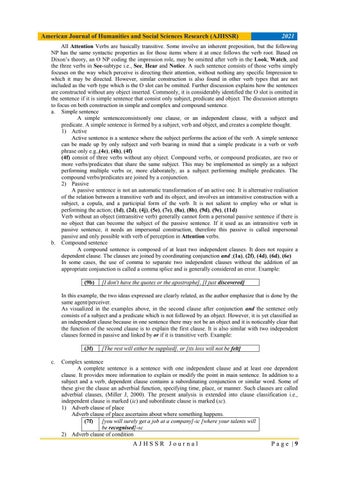American Journal of Humanities and Social Sciences Research (AJHSSR)
2021
All Attention Verbs are basically transitive. Some involve an inherent preposition, but the following NP has the same syntactic properties as for those items where it at once follows the verb root. Based on Dixon’s theory, an O NP coding the impression role, may be omitted after verb in the Look, Watch, and the three verbs in See-subtype i.e., See, Hear and Notice. A such sentence consists of those verbs simply focuses on the way which perceive is directing their attention, without nothing any specific Impression to which it may be directed. However, similar construction is also found in other verb types that are not included as the verb type which is the O slot can be omitted. Further discussion explains how the sentences are constructed without any object inserted. Commonly, it is considerably identified the O slot is omitted in the sentence if it is simple sentence that consist only subject, predicate and object. The discussion attempts to focus on both construction in simple and complex and compound sentence. a. Simple sentence A simple sentenceconsistsonly one clause, or an independent clause, with a subject and predicate. A simple sentence is formed by a subject, verb and object, and creates a complete thought. 1) Active Active sentence is a sentence where the subject performs the action of the verb. A simple sentence can be made up by only subject and verb bearing in mind that a simple predicate is a verb or verb phrase only e.g.,(4e), (4h), (4f) (4f) consist of three verbs without any object. Compound verbs, or compound predicates, are two or more verbs/predicates that share the same subject. This may be implemented as simply as a subject performing multiple verbs or, more elaborately, as a subject performing multiple predicates. The compound verbs/predicates are joined by a conjunction. 2) Passive A passive sentence is not an automatic transformation of an active one. It is alternative realisation of the relation between a transitive verb and its object, and involves an intransitive construction with a subject, a copula, and a participial form of the verb. It is not salient to employ who or what is performing the action; (1d), (2d), (4j), (5e), (7e), (8a), (8b), (9d), (9e), (11d) Verb without an object (intransitive verb) generally cannot form a personal passive sentence if there is no object that can become the subject of the passive sentence. If it used as an intransitive verb in passive sentence, it needs an impersonal construction, therefore this passive is called impersonal passive and only possible with verb of perception in Attention verbs. b. Compound sentence A compound sentence is composed of at least two independent clauses. It does not require a dependent clause. The clauses are joined by coordinating conjunction and ;(1a), (2f), (4d), (6d), (6e) In some cases, the use of comma to separate two independent clauses without the addition of an appropriate conjunction is called a comma splice and is generally considered an error. Example: (9b)
[I don't have the quotes or the apostrophe], [I just discovered]
In this example, the two ideas expressed are clearly related, as the author emphasize that is done by the same agent/perceiver. As visualized in the examples above, in the second clause after conjunction and the sentence only consists of a subject and a predicate which is not followed by an object. However, it is yet classified as an independent clause because in one sentence there may not be an object and it is noticeably clear that the function of the second clause is to explain the first clause. It is also similar with two independent clauses formed in passive and linked by or if it is transitive verb. Example: (3f) c.
[The rest will either be supplied], or [its loss will not be felt]
Complex sentence A complete sentence is a sentence with one independent clause and at least one dependent clause. It provides more information to explain or modify the point in main sentence. In addition to a subject and a verb, dependent clause contains a subordinating conjunction or similar word. Some of these give the clause an adverbial function, specifying time, place, or manner. Such clauses are called adverbial clauses, (Miller J, 2000). The present analysis is extended into clause classification i.e., independent clause is marked (ic) and subordinate clause is marked (sc). 1) Adverb clause of place Adverb clause of place ascertains about where something happens. [you will surely get a job at a company]-ic [where your talents will (7f) be recognised]-sc 2) Adverb clause of condition
AJHSSR Journal
Page |9

